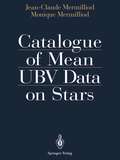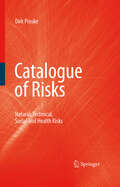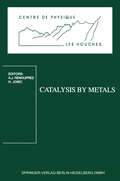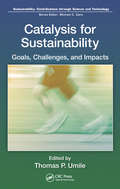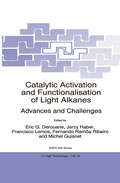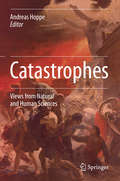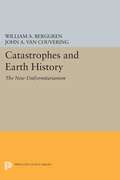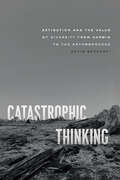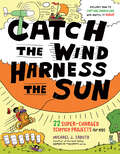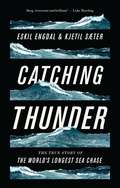- Table View
- List View
Catalogue of Meteorites from South America (SpringerBriefs in Earth System Sciences)
by Rogelio Daniel Acevedo Maximiliano C.L. Rocca Víctor Manuel GarcíaThe first Catalogue of Meteorites from South America includes new specimens never previously reported, while doubtful cases and pseudometeorites have been deliberately omitted.The falling of these objects is a random event, but the sites where old meteorites are found tend to be focused in certain areas, e.g. in the deflation surfaces in Chile’s Atacama Desert, due to favorable climate conditions and ablation processes.Our Catalogue provides basic information on each specimen like its provenance and the place where it was discovered (in geographic co-ordinates and with illustrative maps), its official name, its classification type (class, and if applicable, weathering grade and shock stage), if it was seen falling or was found by chance, its total mass or weight, the institution where it is held, and the most important bibliographic references about it.
Catalogue of Risks: Natural, Technical, Social and Health Risks
by Dirk ProskeSince the German edition of this book, the topic of risk has experienced even greater attention, not only in the world of science but also in other fields, such as economics and politics. Therefore, many new publications have evolved. To keep with the idea of an encyclopedia for the topic of risk, this book has been completely reworked. Not only are many updated examples included in chapter “Risks and disasters” but also new chapters have been introduced, such as the chapter “Indetermination and risk”. This new chapter was developed since the question “Is it possible for risks to be completely eliminated, and if not why?” has become a major point of c- cern. Therefore, especially in this chapter, the focus of the book has - tended from a simple mathematical or engineering point of view to include much broader concepts. Here, not only aspects of system theory have to be considered, but also some general philosophical questions start to inf- ence the considerations of the topic of risk. The main goal of this edition, however, is not only the extension and revision of the book, but also the translation into the English language to allow more readers access to the ideas of the book. The author deeply hopes that the success the book made in the German edition continues and that readers experience a major gain from reading the book.
Catalogue of Selected Angiosperm Pollen Grains from Palaeogene and Neogene Sediments of India (Society of Earth Scientists Series)
by Surya Kant TripathiThis book summarizes the taxonomic details of selected fossil angiosperm pollen genera and species along with their affinity and occurrences in space and time. It provides information about the historical background of palynology from Palaeogene and Neogene sediments in India, general pollen morphology along with the terms commonly used in describing fossil angiosperm pollen and an overview of the Indian Tertiary sediments. A complete list of genera described in this book is given. It also includes a key for identification of Indian angiosperm genera as well as a description of selected fossil angiosperm pollen from India along with their Indian records, illustrations, locality, age and horizon from where these have been reported. In all 130 genera and 402 species have been dealt with. The names of genera and species are arranged alphabetically. The Discussion part includes a summarized account of palynofloras, their biostratigraphic application in various regions of India and their palaeogeographical and palaeoclimatic implications.
Catalunya, One Nation, Two States: An Ethnographic Study of Nonviolent Resistance to Assimilation
by A. AllandThis book deals with the culture of Catalan resistance to assimilation, through the maintenance of the Catalan language as an expression of identity. This book argues that the Catalans also developed a series of cultural mechanisms to foster identity through intellectual and recreational pursuits, as well as through an emphasis on language.
Catalysis by Metals: Les Houches School, March 19–29, 1996 (Centre de Physique des Houches #6)
by Albert Jean Renouprez Herve Jobic JobicCatalytic reactions on metals are still nowadays involved in more than half of the chemical industrial processes. The winter school held at "I 'Ecole de in March 1996, 13 years after the first one, accounts Physique des Houches" for an evolution of the field in several directions. First, the emulation between theoretical chemistry and solid state physics has emerged on heuristic concepts, leading not only to explanations of the observed phenomena but, for the first time, to predictions of the reactivity of catalytic systems and of the reaction pathways. The second domain which during these years has become of primary importance is the abatement of the pollution. It concerns not only the conversion of polluting effluents but more and more major modifications of the processes to avoid the production of undesired products. Two striking examples are the necessary catalytic conversion of the 100 000 cubic meter of hydrogen that would be produced in a major incident of a nuclear power plant and the replacement of the CFC. The valorization of agricultural supplies can already be considered as one of the major achievement of catalysis. Indeed, the carbon of biosustainable raw materials represents more than 2 orders of magnitude the amount extracted from fossil fuels each year. Moreover, the molecules are already highly functionalised in contrast with hydrocarbons which require costly steps to be converted to the same products. They are now of current use in the elaboration of cosmetics, vitamins, polymers, etc.
Catalysis for Sustainability: Goals, Challenges, and Impacts (ISSN)
by Thomas P. UmileCatalysis for Sustainability: Goals, Challenges, and Impacts explores the intersection between catalytic science and sustainable technologies as a means to addressing current economic, social, and environmental problems. These problems include harnessing alternative energy sources, pollution prevention and remediation, and the manufacturing of comm
Catalysis for Sustainability: Goals, Challenges, and Impacts (ISSN)
by Thomas P. UmileCatalysis for Sustainability: Goals, Challenges, and Impacts explores the intersection between catalytic science and sustainable technologies as a means to addressing current economic, social, and environmental problems. These problems include harnessing alternative energy sources, pollution prevention and remediation, and the manufacturing of comm
Catalytic Activation and Functionalisation of Light Alkanes: Advances and Challenges (NATO Science Partnership Subseries: 3 #44)
by E. G. Derouane Jerzy Haber Francisco Lemos Fernando Ramôa Ribeiro Michel GuisnetLight alkanes tend to be resistant to many forms of activation. The horizontal approach of the present book covers homogeneous, heterogeneous and biological catalysis, thus allowing readers to gain an awareness of progress and ideas in research areas different from their own. The book contains both general chapters, giving an overview of the subject, and specialised contributions that deal with the details and state of the art. A specialist report is also included which gives a critical insight into current progress and discusses future prospects and major challenges. Audience: Newcomers and senior researchers in the field of alkane activation. The mixed theoretical and practical approach will be of interest to researchers and industrialists alike.
Catastrophe in the Making: The Engineering of Katrina and the Disasters of Tomorrow
by William R. Freudenburg Robert Gramling Shirley Laska Kai T. EriksonBased on the false promise of widespread prosperity, communities across the U.S. have embraced all brands of “economic development” at all costs. In Louisiana, that meant development interests turning wetlands into shipping lanes. By replacing a natural buffer against storm surges with a 75-mile long, obsolete canal that cost hundreds of millions of dollars, they guided the hurricane into the heart of New Orleans and adjacent communities. The authors reveal why, despite their geographic differences, California and Missouri are building—quite literally—toward similar destruction.Too often, the U.S. “growth machine” generates wealth for a few and misery for many. Drawing lessons from the most expensive “natural” disaster in American history, Catastrophe in the Making shows why thoughtless development comes at a price we can ill afford.
Catastrophe Theory
by Vladimir I. Arnol'dThe new edition of this non-mathematical review of catastrophe theory contains updated results and many new or expanded topics including delayed loss of stability, shock waves, and interior scattering. Three new sections offer the history of singularity and its applications from da Vinci to today, a discussion of perestroika in terms of the theory of metamorphosis, and a list of 93 problems touching on most of the subject matter in the book.
Catastrophes: Views from Natural and Human Sciences
by Andreas HoppeScientific disciplines have their own view on catastrophes. Here, natural scientists, engineers, physicians as well as historians and social scientists define and discuss geo-hazards and associated technical disasters, natural disasters as a business case, medicine and its catastrophes. After war aspects of the Shoah are described with Gershom Sholem´s Concept of Jewish Totality, and the situation of Displaced Persons in Germany as well as the Nakba for Palestinians related to the happiness of Jews celebrating their new State of Israel. The book also reminds of Hamburg’s Flood Disaster in 1962, the Great East Japan Earthquake in 2011 and other historical catastrophes in Japan, the Lisbon earthquake in 1755 and the Age of Enlightenment, and the eruption of the Tambora in 1815 followed by the “year without summer”.
Catastrophes!: Earthquakes, Tsunamis, Tornadoes, and Other Earth-Shattering Disasters
by Donald R. ProtheroDevastating natural disasters have profoundly shaped human history, leaving us with a respect for the mighty power of the earth—and a humbling view of our future. Paleontologist and geologist Donald R. Prothero tells the harrowing human stories behind these catastrophic events.Prothero describes in gripping detail some of the most important natural disasters in history:• the New Madrid, Missouri, earthquakes of 1811–1812 that caused church bells to ring in Boston• the 2004 Indian Ocean tsunami that killed more than 230,000 people• the massive volcanic eruptions of Krakatau, Mount Tambora, Mount Vesuvius, Mount St. Helens, and Nevado del RuizHis clear and straightforward explanations of the forces that caused these disasters accompany gut-wrenching accounts of terrifying human experiences and a staggering loss of human life. Floods that wash out whole regions, earthquakes that level a single country, hurricanes that destroy everything in their path—all are here to remind us of how little control we have over the natural world. Dramatic photographs and eyewitness accounts recall the devastation wrought by these events, and the people—both heroes and fools—that are caught up in the earth's relentless forces. Eerie, fascinating, and often moving, these tales of geologic history and human fortitude and folly will stay with you long after you put the book down.
Catastrophes and Earth History: The New Uniformitarianism (PDF)
by William A. Berggren John A. Van CouveringThis book, based on papers from a symposium at the Woods Hole Oceanographic Institution, shows the necessity of developing a new philosophy in place of the classical uniformitarianism based only on processes familiar in human experience.Originally published in 1984.The Princeton Legacy Library uses the latest print-on-demand technology to again make available previously out-of-print books from the distinguished backlist of Princeton University Press. These editions preserve the original texts of these important books while presenting them in durable paperback and hardcover editions. The goal of the Princeton Legacy Library is to vastly increase access to the rich scholarly heritage found in the thousands of books published by Princeton University Press since its founding in 1905.
Catastrophic Events Caused by Cosmic Objects
by Vitaly Adushkin Ivan NemchinovAn asteroid or comet will inevitably strike the Earth some day, and potentially cause great destruction. This volume considers hazards due to collisions with cosmic objects, particularly in light of recent investigations of impacts by the authors. Each chapter, written by an expert, contains an overview of an aspect and new findings in the field. Coverage describes and numerically estimates the main hazardous effects.
Catastrophic Thinking: Extinction and the Value of Diversity from Darwin to the Anthropocene (science.culture)
by David SepkoskiWe live in an age in which we are repeatedly reminded—by scientists, by the media, by popular culture—of the looming threat of mass extinction. We’re told that human activity is currently producing a sixth mass extinction, perhaps of even greater magnitude than the five previous geological catastrophes that drastically altered life on Earth. Indeed, there is a very real concern that the human species may itself be poised to go the way of the dinosaurs, victims of the most recent mass extinction some 65 million years ago. How we interpret the causes and consequences of extinction and their ensuing moral imperatives is deeply embedded in the cultural values of any given historical moment. And, as David Sepkoski reveals, the history of scientific ideas about extinction over the past two hundred years—as both a past and a current process—is implicated in major changes in the way Western society has approached biological and cultural diversity. It seems self-evident to most of us that diverse ecosystems and societies are intrinsically valuable, but the current fascination with diversity is a relatively recent phenomenon. In fact, the way we value diversity depends crucially on our sense that it is precarious—that it is something actively threatened, and that its loss could have profound consequences. In Catastrophic Thinking, Sepkoski uncovers how and why we learned to value diversity as a precious resource at the same time as we learned to think catastrophically about extinction.
Catastrophic Thinking: Extinction and the Value of Diversity from Darwin to the Anthropocene (science.culture)
by David SepkoskiWe live in an age in which we are repeatedly reminded—by scientists, by the media, by popular culture—of the looming threat of mass extinction. We’re told that human activity is currently producing a sixth mass extinction, perhaps of even greater magnitude than the five previous geological catastrophes that drastically altered life on Earth. Indeed, there is a very real concern that the human species may itself be poised to go the way of the dinosaurs, victims of the most recent mass extinction some 65 million years ago. How we interpret the causes and consequences of extinction and their ensuing moral imperatives is deeply embedded in the cultural values of any given historical moment. And, as David Sepkoski reveals, the history of scientific ideas about extinction over the past two hundred years—as both a past and a current process—is implicated in major changes in the way Western society has approached biological and cultural diversity. It seems self-evident to most of us that diverse ecosystems and societies are intrinsically valuable, but the current fascination with diversity is a relatively recent phenomenon. In fact, the way we value diversity depends crucially on our sense that it is precarious—that it is something actively threatened, and that its loss could have profound consequences. In Catastrophic Thinking, Sepkoski uncovers how and why we learned to value diversity as a precious resource at the same time as we learned to think catastrophically about extinction.
Catastrophic Thinking: Extinction and the Value of Diversity from Darwin to the Anthropocene (science.culture)
by David SepkoskiWe live in an age in which we are repeatedly reminded—by scientists, by the media, by popular culture—of the looming threat of mass extinction. We’re told that human activity is currently producing a sixth mass extinction, perhaps of even greater magnitude than the five previous geological catastrophes that drastically altered life on Earth. Indeed, there is a very real concern that the human species may itself be poised to go the way of the dinosaurs, victims of the most recent mass extinction some 65 million years ago. How we interpret the causes and consequences of extinction and their ensuing moral imperatives is deeply embedded in the cultural values of any given historical moment. And, as David Sepkoski reveals, the history of scientific ideas about extinction over the past two hundred years—as both a past and a current process—is implicated in major changes in the way Western society has approached biological and cultural diversity. It seems self-evident to most of us that diverse ecosystems and societies are intrinsically valuable, but the current fascination with diversity is a relatively recent phenomenon. In fact, the way we value diversity depends crucially on our sense that it is precarious—that it is something actively threatened, and that its loss could have profound consequences. In Catastrophic Thinking, Sepkoski uncovers how and why we learned to value diversity as a precious resource at the same time as we learned to think catastrophically about extinction.
Catastrophic Thinking: Extinction and the Value of Diversity from Darwin to the Anthropocene (science.culture)
by David SepkoskiWe live in an age in which we are repeatedly reminded—by scientists, by the media, by popular culture—of the looming threat of mass extinction. We’re told that human activity is currently producing a sixth mass extinction, perhaps of even greater magnitude than the five previous geological catastrophes that drastically altered life on Earth. Indeed, there is a very real concern that the human species may itself be poised to go the way of the dinosaurs, victims of the most recent mass extinction some 65 million years ago. How we interpret the causes and consequences of extinction and their ensuing moral imperatives is deeply embedded in the cultural values of any given historical moment. And, as David Sepkoski reveals, the history of scientific ideas about extinction over the past two hundred years—as both a past and a current process—is implicated in major changes in the way Western society has approached biological and cultural diversity. It seems self-evident to most of us that diverse ecosystems and societies are intrinsically valuable, but the current fascination with diversity is a relatively recent phenomenon. In fact, the way we value diversity depends crucially on our sense that it is precarious—that it is something actively threatened, and that its loss could have profound consequences. In Catastrophic Thinking, Sepkoski uncovers how and why we learned to value diversity as a precious resource at the same time as we learned to think catastrophically about extinction.
Catastrophic Thinking: Extinction and the Value of Diversity from Darwin to the Anthropocene (science.culture)
by David SepkoskiA history of scientific ideas about extinction that explains why we learned to value diversity as a precious resource at the same time as we learned to “think catastrophically” about extinction. We live in an age in which we are repeatedly reminded—by scientists, by the media, by popular culture—of the looming threat of mass extinction. We’re told that human activity is currently producing a sixth mass extinction, perhaps of even greater magnitude than the five previous geological catastrophes that drastically altered life on Earth. Indeed, there is a very real concern that the human species may itself be poised to go the way of the dinosaurs, victims of the most recent mass extinction some 65 million years ago. How we interpret the causes and consequences of extinction and their ensuing moral imperatives is deeply embedded in the cultural values of any given historical moment. And, as David Sepkoski reveals, the history of scientific ideas about extinction over the past two hundred years—as both a past and a current process—is implicated in major changes in the way Western society has approached biological and cultural diversity. It seems self-evident to most of us that diverse ecosystems and societies are intrinsically valuable, but the current fascination with diversity is a relatively recent phenomenon. In fact, the way we value diversity depends crucially on our sense that it is precarious—that it is something actively threatened, and that its loss could have profound consequences. In Catastrophic Thinking, Sepkoski uncovers how and why we learned to value diversity as a precious resource at the same time as we learned to think catastrophically about extinction.
Catch the Wind, Harness the Sun: 22 Super-Charged Projects for Kids
by Michael J. CadutoGet charged up about energy! With more than 20 fun activities and experiments that will have children ages 8 to 12 enthusiastically engaged with making and using renewable energy, Michael J. Caduto takes a hands-on approach to fighting climate change. Step-by-step instructions for projects range from using the sun to make fires to charging electronic devices by peddling your bicycle. Additional energy case studies encourage kids to think about the basic tenets of resource management. Change the world — one miniature windmill at a time.
Catching Thunder: The True Story of the World’s Longest Sea Chase
by Eskil Engdal Kjetil SæterDecember, 2014: In the forbidding waters off Antarctica, Captain Hammarstedt of the Bob Barker sets off on a voyage unlike any seen before. Across ten thousand miles of hazardous seas, Hammarstedt's crew will relentlessly pursue the Thunder – an infamous illegal fishing ship – for what will become the longest chase in maritime history. Wanted by Interpol, the Thunder has for years evaded justice: hunting endangered species and accumulating millions in profits.The authors follow this incredible expedition from the beginning. But even as seasoned journalists, they cannot anticipate what the chase will uncover, as the wake of the Thunder leads them on the trail of criminal kingpins, rampant corruption, modern slavery and an international community content to turn a blind eye. Very soon, catching Thunder becomes not only a chase but a pursuit of the truth itself – and a symbolic race to preserve the well-being of our planet.A Scandinavian bestseller, Catching Thunder is a remarkable true story of courage and perseverance, and a wake-up call to act against the destruction of our environments.
Catching Thunder: The True Story of the World’s Longest Sea Chase
by Eskil Engdal Kjetil SæterDecember, 2014: In the forbidding waters off Antarctica, Captain Hammarstedt of the Bob Barker sets off on a voyage unlike any seen before. Across ten thousand miles of hazardous seas, Hammarstedt's crew will relentlessly pursue the Thunder – an infamous illegal fishing ship – for what will become the longest chase in maritime history. Wanted by Interpol, the Thunder has for years evaded justice: hunting endangered species and accumulating millions in profits.The authors follow this incredible expedition from the beginning. But even as seasoned journalists, they cannot anticipate what the chase will uncover, as the wake of the Thunder leads them on the trail of criminal kingpins, rampant corruption, modern slavery and an international community content to turn a blind eye. Very soon, catching Thunder becomes not only a chase but a pursuit of the truth itself – and a symbolic race to preserve the well-being of our planet.A Scandinavian bestseller, Catching Thunder is a remarkable true story of courage and perseverance, and a wake-up call to act against the destruction of our environments.
Catchment and River Basin Management: Integrating Science and Governance (Earthscan Studies in Water Resource Management)
by Laurence Smith Keith Porter Kevin Hiscock Mary Jane Porter David BensonThe central focus of this volume is a critical comparative analysis of the key drivers for water resource management and the provision of clean water – governance systems and institutional and legal arrangements. The authors present a systematic analysis of case study river systems drawn from Australia, Denmark, Germany, the Netherlands, UK and USA to provide an integrated global assessment of the scale and key features of catchment management. A key premise explored is that despite the diversity of jurisdictions and catchments there are commonalities to a successful approach. The authors show that environmental and public health water quality criteria must be integrated with the economic and social goals of those affected, necessitating a 'twin-track' and holistic (cross-sector and discipline) approach of stakeholder engagement and sound scientific research. A final synthesis presents a set of principles for adaptive catchment management. These principles demonstrate how to integrate the best scientific and technical knowledge with policy, governance and legal provisions. It is shown how decision-making and implementation at the appropriate geographic and governmental scales can resolve conflicts and share best sustainable practices.
Catchment and River Basin Management: Integrating Science and Governance (Earthscan Studies in Water Resource Management)
by Laurence Smith Keith Porter Kevin Hiscock Mary Jane Porter David BensonThe central focus of this volume is a critical comparative analysis of the key drivers for water resource management and the provision of clean water – governance systems and institutional and legal arrangements. The authors present a systematic analysis of case study river systems drawn from Australia, Denmark, Germany, the Netherlands, UK and USA to provide an integrated global assessment of the scale and key features of catchment management. A key premise explored is that despite the diversity of jurisdictions and catchments there are commonalities to a successful approach. The authors show that environmental and public health water quality criteria must be integrated with the economic and social goals of those affected, necessitating a 'twin-track' and holistic (cross-sector and discipline) approach of stakeholder engagement and sound scientific research. A final synthesis presents a set of principles for adaptive catchment management. These principles demonstrate how to integrate the best scientific and technical knowledge with policy, governance and legal provisions. It is shown how decision-making and implementation at the appropriate geographic and governmental scales can resolve conflicts and share best sustainable practices.
